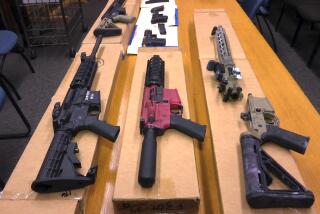Court OKs Use of Minors in Police Liquor Sales Stings
- Share via
SAN FRANCISCO — Reviving an important statewide law enforcement program, the California Supreme Court held Thursday that police may use teen-age decoys to determine whether stores, restaurants and bars illegally sell alcohol to minors.
In a unanimous decision, the state’s high court overturned a 1993 Court of Appeal ruling that halted the teen-age decoy program, which state officials say had snagged as many as 2,000 proprietors a year for selling alcohol to minors.
Grocers and others have strongly objected to the 8-year-old effort, complaining that it targets proprietors with no record of selling to minors and deploys decoys who appear far older than their years.
But Jay Stroh, director of the California Department of Alcoholic Beverage Control, called the decoy program “an extremely important tool” in enforcing the state law.
A Court of Appeal in San Francisco ruled that the program was unconstitutional. Although the state’s Constitution prohibits the sale of alcohol to minors, the court ruled, it does not contain an exception for minors working for law enforcement agencies.
But Chief Justice Malcolm Lucas, writing for the Supreme Court, said stores and other establishments can be fined or lose their licenses for selling to these youthful undercover police recruits.
“Police involvement in criminal activity for the purpose of investigating possible violations is permissible even if technical violations of the law occur,” Lucas wrote.
Before the Court of Appeal ruling, a majority of local law enforcement agencies in the state were using teen-age decoys, Stroh said. His department will now notify them to resume the practice.
Police and the decoys, often police cadets or Explorers, usually visit 15 to 20 stores or bars a night, Stroh said. In the 1991-92 fiscal year, 1,500 merchants were charged with selling alcohol to minors. Of those, 1,000 were charged because of sales to decoys. The penalty for a first offense can be a license suspension of several days or fines of as much as $1,500.
If the court had ruled the program unconstitutional, “it would have called into question every sting program you can think of,” said Deputy Atty. Gen. Thomas Scheerer.
The case was brought by Lucky Stores and Provigo Corp., owner of Petrini stores in the Bay Area, which faced suspension of their licenses for selling to teen-age police decoys in 1990.
One of the decoys was a 5-foot, 7-inch, 170-pound, 19-year-old boy who bought liquor from a Lucky store in the East Bay city of Concord. The other was a 200-pound, 6-foot, 1-inch, 17-year-old boy who purchased liquor from Petrini’s in San Leandro, also in the East Bay.
In protesting the suspension of their licenses, the stores argued that the use of underage decoys was unconstitutional. They also complained they had been entrapped and that their rights had been violated because the police deployed mature-looking decoys in violation of state guidelines.
Alcoholic Beverage and Control guidelines advise police to use decoys who look well under 21, the legal drinking age.
“As a general rule,” the high court said, “the use of decoys to expose illicit activity does not constitute entrapment, so long as no pressure or overbearing conduct is employed by the decoy.”
In overturning the appellate court’s decision, the Supreme Court said it was not limited by the words of the Constitution, but could seek a “practical, common-sense” interpretation consistent with the law’s intent.
Renee D. Wasserman, an attorney for the stores, called the ruling an “activist decision” and a break from the California Supreme Court’s generally strict reliance on the wording of the Constitution.
She said grocers are now working in the Legislature to develop a bill that would require police departments to meet standard guidelines in the use of their decoys and to prevent them from targeting stores randomly.
“This is a multiracial society and a society where people expect quick service,” Wasserman said. “The retailer has to make a quick decision as to whether they think somebody is over the age of 21 or not.”
More to Read
Sign up for Essential California
The most important California stories and recommendations in your inbox every morning.
You may occasionally receive promotional content from the Los Angeles Times.














